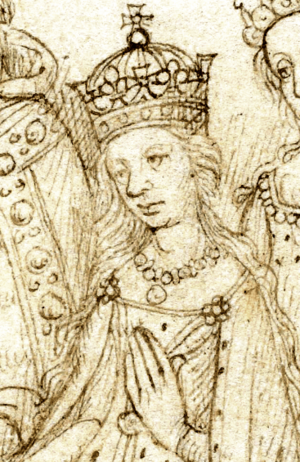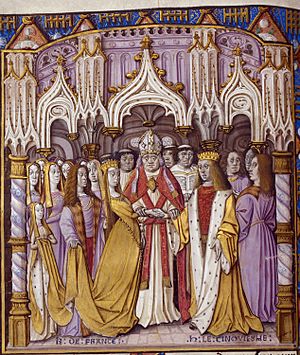Catherine of Valois facts for kids
Quick facts for kids Catherine of Valois |
|
|---|---|

Drawing from the Beauchamp Pageant, c. 1483–1494
|
|
| Queen consort of England | |
| Tenure | 2 June 1420 – 31 August 1422 |
| Coronation | 23 February 1421 |
| Born | 27 October 1401 Hôtel Saint-Pol, France |
| Died | 3 January 1437 (aged 35) London, England |
| Burial | Westminster Abbey, London |
| Spouse |
|
| Issue Detail |
|
| House | Valois |
| Father | Charles VI of France |
| Mother | Isabeau of Bavaria |
Catherine of Valois (born 27 October 1401 – died 3 January 1437) was the Queen of England from 1420 to 1422. She was a French princess, daughter of Charles VI of France. Catherine married Henry V of England and became the mother of his heir, Henry VI of England.
Her marriage was part of a big plan to make Henry V the King of France. This was meant to help end the long conflict known as the Hundred Years' War. Even though her son, Henry VI, was later crowned in Paris, the plan didn't fully succeed.
After Henry V died, Catherine married Owen Tudor. This marriage was very important for the future of the Tudor dynasty. Their grandson eventually became Henry VII of England, a famous king. Catherine's older sister, Isabella, was also a Queen of England. She married Richard II of England when she was a child.
Contents
Catherine's Early Life
Catherine of Valois was the youngest daughter of King Charles VI of France and Queen Isabeau of Bavaria. She was born in Paris at the Hôtel Saint-Pol on 27 October 1401.
When she was young, there were talks about her marrying the Prince of Wales. He was the son of Henry IV of England. However, King Henry IV died before these talks could properly begin. In 1414, the prince became King Henry V of England. He then started discussions again about marrying Catherine. He also wanted a large dowry (money or property given by the bride's family) and for France to agree to his claim to the French throne.
Some old stories said that Catherine's mother didn't care for her much. But newer studies show this wasn't true. Records show that her mother bought toys for Catherine, just like for any French princess. Catherine also received religious books and went to a convent in Poissy for her education.
Becoming a Royal Queen
King Henry V went to war with France. Even after his big victory at the Battle of Agincourt, plans for his marriage to Catherine continued. People said Catherine was very beautiful. When Henry finally met her in Meulan, he was very impressed.
In May 1420, England and France made a peace agreement called the Treaty of Troyes. In this treaty, King Charles VI of France agreed that Henry V of England would be his heir. Catherine and Henry were married on 2 June 1420. The wedding took place either at the Parish Church of St John or at Troyes Cathedral.
Catherine then traveled to England with her new husband. She was crowned queen in Westminster Abbey on 23 February 1421. In June 1421, Henry went back to France to continue his military campaigns.
By this time, Catherine was pregnant. She gave birth to a son, named Henry, on 6 December 1421 at Windsor. Sadly, her husband, King Henry V, never saw their child. He became sick during a battle and died on 31 August 1422. He was almost 36 years old.
Catherine was not yet 21 when she became a queen dowager (a queen whose husband has died). A few months after Henry V, King Charles VI of France also died. This made young Henry VI the king of both England and the parts of northern France that England controlled. Catherine loved her son very much during his early childhood.
Catherine and Owen Tudor
Catherine was still young and could marry again. This worried her brother-in-law, Humphrey, Duke of Gloucester. He was in charge of her young son, the king. There were rumors that Catherine wanted to marry Edmund Beaufort, who was her late husband's cousin.
The Duke of Gloucester was strongly against this marriage. So, in 1427–1428, Parliament passed a law. This law said that if the queen dowager married again without the king's permission, her new husband would lose his lands and money. However, any children from the marriage would not be punished. The king's permission could only be given once he was an adult. At that time, the king was only six years old.
Catherine lived in the king's household. This was partly so she could care for her son. But it also allowed the king's advisors to keep an eye on her. Owen Tudor was likely hired to manage Catherine's household. Their relationship began when Catherine lived at Windsor Castle. She became pregnant with their first child there.
At some point, Catherine stopped living in the king's household. In May 1432, Parliament gave Owen the rights of an Englishman. This was important because of old laws that limited the rights of Welsh people.
We don't know the exact date Catherine married Owen. But there is no proof from that time that anyone questioned if their marriage was real or if their children were legitimate. The Tudor dynasty of England came from Owen Tudor and Queen Catherine. This started with King Henry VII. Later historians from the Tudor period said that Owen and Catherine were married. This made the Tudor family's claim to the throne seem more proper and royal.
Owen and Catherine had at least six children. Their sons, Edmund, Jasper, and Edward, were all born away from the royal court. They also had a daughter named Margaret, who became a nun and died young.
Her Death and What Happened Next
Catherine died on 3 January 1437 in London. She died shortly after giving birth. She was buried in the old Lady Chapel at Westminster Abbey. While her death date is clear, the exact cause is debated. Some records say she died from an illness she had for some time, not from childbirth. She might have gone to Bermondsey Abbey seeking a cure. Catherine wrote her will just three days before she died. Today, her remains are in Henry V's Chapel at Westminster Abbey.
After Catherine's death, her enemies decided to take action against Owen Tudor. They said he broke the law about the queen dowager remarrying. Owen appeared before the council, was arrested, and sent to Newgate Prison. He tried to escape from Newgate in early 1438. He eventually ended up at Windsor Castle in July of that year.
Meanwhile, Owen and Catherine's two older sons, Edmund and Jasper, went to live with Katherine de la Pole. She was the Abbess of Barking Abbey and sister of William de la Pole, 1st Duke of Suffolk. Sometime after 1442, their half-brother, King Henry VI, took a role in raising them.
Owen, their father, was eventually released after paying a large bail. He was officially pardoned in November 1439. Owen was treated well after this and was part of the king's household until the mid-1450s. He lived until 1461. He was executed by the Yorkists after the Battle of Mortimer's Cross.
Catherine's son, King Henry VI, gave earldoms to her sons with Owen. Edmund married Margaret Beaufort. She was a descendant of John of Gaunt and had a distant claim to the throne. After many other possible heirs died in wars, their son became King Henry VII.
The wooden statue (called an funeral effigy) that was carried at Catherine's funeral is still at Westminster Abbey. It used to be in the Westminster Abbey Museum. Now, it is displayed in the new Queen's Diamond Jubilee Gallery. Her tomb originally had a beautiful alabaster memorial. But this was purposely destroyed when her grandson, Henry VII, extended the abbey. Some people think Henry ordered it removed to distance himself from his family's origins through Owen Tudor. At this time, her coffin lid was accidentally opened. Her body was seen and became a strange tourist attraction for many years. Catherine's remains were finally properly re-buried during the time of Queen Victoria.
Catherine in Stories and Films
- William Shakespeare's play Henry V (around 1599) shows Catherine of Valois' marriage to Henry V of England.
- Mary Pix's play Queen Catherine; or, the Ruines of Love (1698) shows the end of Catherine's relationship with Owen Tudor.
- Catherine of Valois is the main character in Rosemary Hawley Jarman's novel Crown in Candlelight (1978).
- Margaret Frazer's mystery The Boy's Tale (1995) features Catherine and her sons Edmund and Jasper.
- In The Queen's Secret by Jean Plaidy, Catherine is the main character.
- Another novel by Jean Plaidy, Epitaph for Three Women, tells the story of Henry VI's childhood through Catherine, Joan of Arc, and Eleanor, Duchess of Gloucester.
- In the historical novel Fortune Made His Sword by Martha Rofheart, Catherine is one of five people who tell the story of Henry V.
- Dedwydd Jones's novel The Lily and the Dragon (2002) tells the story of Owain Tudor and Catherine of Valois.
- Joanna Hickson's novel The Agincourt Bride (2013) tells Catherine's early life. Its sequel The Tudor Bride (2014) tells about her life as queen and her relationship with Owen Tudor.
- Anne O'Brien's novel The Forbidden Queen (2013) shares details about Catherine of Valois's life.
- Vanora Bennett's novel Blood Royal/The Queen's Lover (2009) tells Catherine's story from her early years to her secret marriage to Owen Tudor.
- Mari Griffith's novel Root of the Tudor Rose (2014) is about Catherine's short marriage to Henry V and her secret relationship with Owain ap Maredydd ap Tudur.
- Rosemary Anne Sisson's play The Queen and the Welshman (1957) tells the story of Catherine de Valois and Owen.
- In the Laurence Olivier film Henry V (1944), Catherine is played by Renée Asherson.
- In the Kenneth Branagh film Henry V (1989), Catherine is played by Emma Thompson.
- In the Netflix film The King (2019), Catherine is played by Lily-Rose Depp.
Sources
- de Gibours, Anselm (1726) (in fr). Histoire généalogique et chronologique de la maison royale de France. 1 (3rd ed.). Paris: La compagnie des libraires. https://books.google.com/books?id=n9lEAAAAcAAJ.
See also
 In Spanish: Catalina de Valois (1401-1437) para niños
In Spanish: Catalina de Valois (1401-1437) para niños



